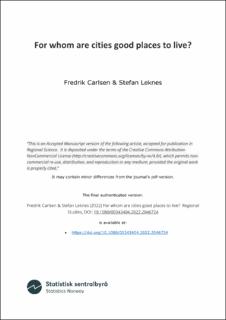| dc.contributor.author | Carlsen, Fredrik | |
| dc.contributor.author | Leknes, Stefan | |
| dc.date.accessioned | 2022-11-23T13:51:13Z | |
| dc.date.available | 2022-11-23T13:51:13Z | |
| dc.date.created | 2022-04-04T12:11:43Z | |
| dc.date.issued | 2022 | |
| dc.identifier.citation | Regional studies. 2022, . | en_US |
| dc.identifier.issn | 0034-3404 | |
| dc.identifier.uri | https://hdl.handle.net/11250/3033705 | |
| dc.description.abstract | In this paper we use survey data to examine heterogeneity in the urban gradient of life satisfaction. Are some sociodemographic groups more satisfied in cities than others? We find that young persons with tertiary education generally report higher levels of life satisfaction in Norway’s largest city, Oslo, whereas the elderly and the less educated are more satisfied elsewhere. These results may shed light on the ‘urban paradox’: the tendency of large cities in developed countries to have low levels of average subjective well-being and also why the received literature has produced mixed results, as the sociodemographic composition of cities varies. | en_US |
| dc.language.iso | eng | en_US |
| dc.title | For whom are cities good places to live? | en_US |
| dc.title.alternative | For whom are cities good places to live? | en_US |
| dc.type | Journal article | en_US |
| dc.type | Peer reviewed | en_US |
| dc.description.version | acceptedVersion | en_US |
| dc.source.pagenumber | 14 | en_US |
| dc.source.journal | Regional studies | en_US |
| dc.identifier.doi | 10.1080/00343404.2022.2046724 | |
| dc.identifier.cristin | 2015100 | |
| dc.relation.project | Norges forskningsråd: 280393 | en_US |
| dc.relation.project | Norges forskningsråd: 255509 | en_US |
| dc.relation.project | Norges forskningsråd: 295989 | en_US |
| cristin.ispublished | true | |
| cristin.fulltext | postprint | |
| cristin.fulltext | postprint | |
| cristin.qualitycode | 1 | |
